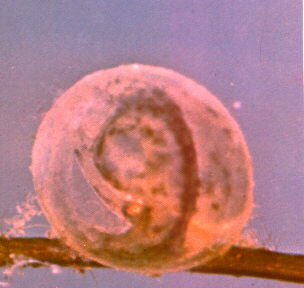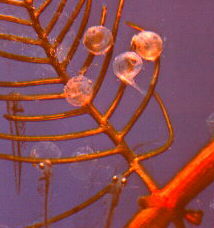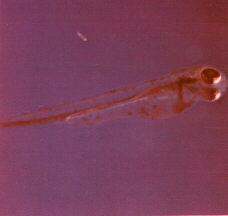If you are simply contemplating the breeding of your own pet Goldfish please keep in mind that Goldfish are living creatures that will need to be cared for humanely. Raising fry successfully will take time and work. It will also require a good amount of tank space and can become costly. Unless you have the time, space and money and know what you will do with all of the offspring it may be best for the fishes sake as well as your own not to breed at all. Be aware that there is no profit to be made by the home aquarist when it comes to breeding Goldfish. Goldfish are bred commercially on farms all over the world and most come rather cheaply to the average pet shop leaving no market for home bred specimens. At best, some shops would only be willing to accept home bred offspring as feeder fish and most would not be willing to pay for them.
Sexing Goldfish
Determining the sex of young Goldfish, especially those under one year of age, can be almost impossible. Sexing adult Goldfish can also be difficult, especially to the untrained eye. However, when fish are mature there are certain indicators that help to distinguish the sexes.
The most reliable method of sexing Goldfish is to observe the vent or anal opening of the fish. The males opening is small, oval shaped and inverted. The females opening is larger, more circular in shape and protruding.

male

female
A less reliable method of sexing is only possible when fish are in breeding condition. At this time males develop what are called breeding Tubercles. Tubercles are small white "pimple-like" bumps which can be seen on the gill plates as well as the leading rays of the fins, particularly the first ray of the pectoral fins. Tubercles appear just before breeding season and gradually dissappear after spawning. Females in breeding condition will take on a more full bodied, broader appearence. Colors of both sexes will intensify, more so in males.
Pairing
The quality of the offspring produced depends greatly on the quality of the parent fish. Young fish, between the ages of 2 and 4 years old, are best for breeding. Younger fish may throw few eggs, which are generally smaller and less viable. Older fish may throw a great number of larger eggs which are often deformed and infertile.
Fish chosen for breeding should exhibit the best qualities of the breed being bred. Finnage, body shape, size and color should all be considered. Only fish showing the best of all qualities should be chosen.
Potential breeders should be of good size (4 to 6 inches or larger), as smaller fish which may be stunted do not make good breeders. Fish should also be in good overall health.
Pre-Spawning Conditioning
In order to ensure a good, healthy batch of fry proper conditioning of the prospective parents is essential. Strong, healthy, well-conditioned parent fish will spawn more readily, produce more eggs, have a higher fertility rate of the eggs laid and hatch out stronger, healthier fry.
As fish prepare for spawning all nutrients taken in will go towards building healthy viable eggs in females and milt in males. The importance of a good and varied diet during this time can not be overstated. Heavy feeding with nutritious, high protein foods such as live insects and insect larvae, worms, and brine shrimp will help to ready the fish for spawning as well as help to ensure good strong eggs and fry.
Thick clumps of bushy plants should be added to the aquarium or pond at this time to serve as a spawning site (a place for fish to lay their eggs). Sponge filters also make for a good spawning medium.
Spawning
When conditions are right and Goldfish are ready for spawning, you will first notice the fish grouping together while swimming. Colors of both sexes will intensify and males will begin to randomly chase females. Soon after, the more active males will single out a female and drive her vigorously through the water and into plants or other spawning medium. As actual spawning nears this driving will become more violent and prolonged.
Actual spawning consists of the male pushing against the female while both fish gyrate from side to side. This causes the female to expell her eggs so that the male can fertilize them by depositing milt over them. Eggs fall through the water and become attached to plants or other medium by sticky threads where they will remain, if not eaten, until hatched. Spawning usually takes place in the early morning hours and may continue for several hours per day with brief resting periods between spawnings. Periods of spawning may continue for several days.

goldfish eggs
A single female can lay up to 10,000 eggs at one time. However many of the eggs may be lost if the parent fish are not removed. Goldfish, having no parenting instincts, will readily devour as many eggs as possible, even during the actual spawning period.
Egg Development And Hatching
Goldfish eggs resemble tiny transparent bubbles, with fertile eggs being clear and pale amber to pale yellow in color. Infertile eggs generally become opaque (white) within twenty four hours and eventually become fungus covered.

three day old goldfish egg
Fry development begins once eggs are fertilized. At two to three days pigmented eyes, small pigment spots on the body and a beating heart can be seen on the developing embryos. The embryos will also begin to wriggle inside the egg.

five day old goldfish eggs
By the fifth day embryos and yolk sacs are heavily pigmented. On the fifth to seventh day the eggs open up and larval fish burst out, tail first, with yolk sacs attached to their bellies. This sac will nourish the newly hatched fry for the first few days of life. For the next 48 hours the 1/4 of an inch (5 mm) long larvae cling to plants and sides of the pond or aquarium by sticky head glands. They are able to jerk about in the water but can not sustain normal swimming motion and will spend much of their time resting. At approximately two to three days old the yolk sacs are absorbed and the fry begin to swim freely in search of food.

nine day old fry
A month or so after hatching the fry begin to look like Goldfish and a covering of scales can be seen. Changes in coloration will also begin and may continue for the first one to three years of the Goldfishes life. After only a few short months, by fall if hatched in spring, the fry are considered adult fish.
Caring For Fry
For proper development and overall health an abundance of nutritional foods must be fed to the fry right from the start. In an outdoor environment such as a pond, where water is rich with nutrients, little to no supplimentory foods may be needed. In an aquarium however, the proper foods must be provided. A solution of hard boiled egg yolk and water makes an excellent first food. Live foods such as newly hatched Infusoria, Daphnia and Brine Shrimp are also good food sources. Commercially produced powdered fry foods are also available and should be readily accepted by young Goldfish. Feeding heavily, 4 to 6 times per day, is recommended for the first few weeks of life.
In addition to diet, environmental factors must also be considered. In the early stages of development Goldfish fry are extremely delicate and require good, stable water conditions and temperatures to insure survival. Any sudden changes in their environment can easily kill the entire batch. Good, stable conditions must be maintained to insure a successful batch of fry.
Breeding In The Home Aquarium
Goldfish are extremely prolific and will spawn readily when kept outdoors in spacious ponds. However breeding in the home aquarium may take a bit of work. Goldfish kept outdoors breed according to the seasons, spawning in spring and early summer. Most fish kept in home aquariums never experience these seasonal changes and therefore some coaxing may be needed.
Breeding Goldfish indoors can be done in as little as 20 gallons of water, depending on the size of the parent fish. Rearing the fry however may require massive amounts of tank space, depending on the amount of fry in any given batch. Since a single female can lay up to 10,000 eggs at one time if adequate tank space is not available to accomadate the fry breeding should not be attempted. Once you are prepared, there are some steps you can take to increase the chances of spawning in the home aquarium.
To begin, the temperature of the breeding tank should gradually be lowered to simulate the fall and winter months, being sure the change is made slowly over a period of at least several days to avoid shocking the fish. Breeder fish should be kept at a temperature of 50 degrees for about 7 weeks. Afterwhich the temperature should gradually be raised to 60 degrees to simulate the coming of spring and to bring on the pre-spawning period. Finally, the temperature is gradually raised to 74 degrees in preperation for spawning. Heavy feeding with high protein foods should commence and thick clumps of bushy plants such as Myriophyllum, Hair Grass, Anacharis or other fine floating plants or some type of artificial spawning media, such as a spawning mop, should be added to the aquarium to recieve the eggs. If all has gone well the fish should be ready to spawn.
After spawning has occured and eggs have been layed and fertilized the parent fish should be removed from the aquarium immediately as they will both quickly devour the eggs. Infertile eggs, which may become fungus covered, should be removed to prevent any fertile eggs in surrounding areas from becoming fungused as well.